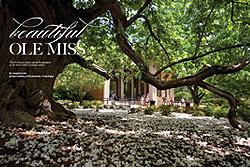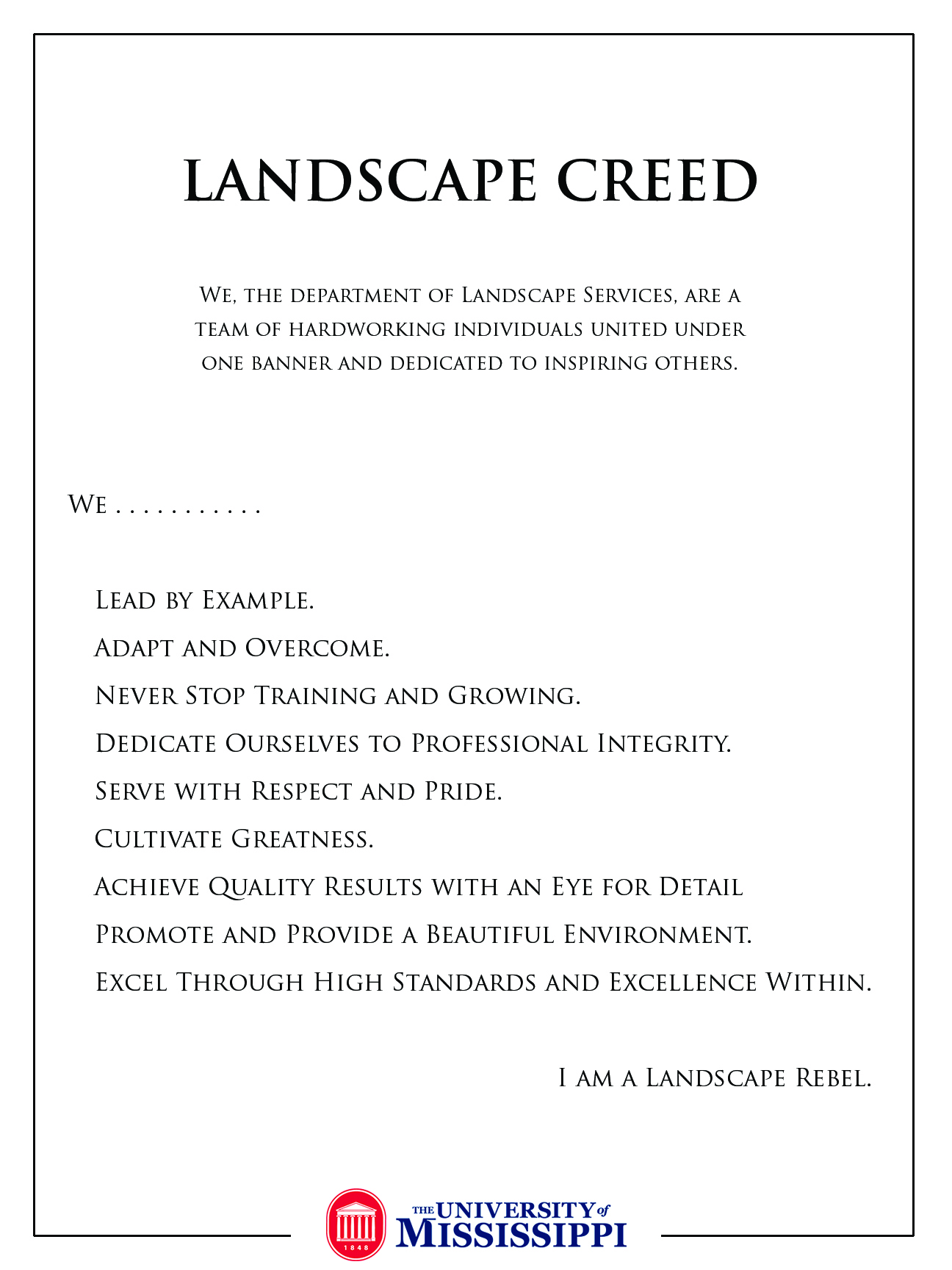Frequently Asked Questions
By: Jeff McManus, Director of Landscape Services, University of Mississippi
1. Keep your beds protected and looking fresh with mulches such as pine straw, wood chips or pine bark. Mulches are not only aesthetically pleasing, but also help stop weeds, hold in moisture for plant roots, and help prevent soil crusting and help prevent erosion.
2. Keep turf lines and hard edges such as sidewalks & curbs edged. Grass growing into shrub beds and over hard surfaces detract from the defined look of the yard. Crisp bed lines of mulch next to turf give great definition to any yard.
3. Develop any "eye for detail" and see the little things that make a yard gorgeous. For example, don't let hedges get over grown or cover up windows and put the right plant in the right location. If you are constantly fighting a shrub to stay small, you may have the right plant, but in the wrong location.
4. Keeping life simple is important. Landscape maintenance can be simple if you take the time up front to plan and invest the right way. You will enjoy your yard more if you do not constantly have to go back and do the same dreadful task over and over again. Find simple ways to manage the yard. I hate to pull weeds, so I don't. I use pre-emergent and post-emergent herbicides to control weeds. The thrill of the kill saves me time to do other things I really like to do in the yard.
5. Do you have low hanging limbs that hit you in the face when you moe? If so, lift those limbs up and enjoy the view as well as not getting slapped by a limb every week.
6. Seasonal and perennial flowers, such as impatients and daylilies are great for color. Pick out or create focal points around the yard such as entrances, curves, pots, and hanging baskets that may "wow" your guest and you.
7. Pick the right plant for the location. Some plants like to stay tight and grow well next to the sidewalks such as Nandina. Others do not, they may like to stay tight and enjoy growing big and wild like Eleaganus.
8. Over-seed your lawn or repair areas with sod. Make sure you water the lawn when needed. Bare spots take away from the overall appearance of the yard.
9. Mow turf with sharp blades. Do not remove more than 1/3 off the height of the turf canopy with any one mowing. Do not "scalp" the lawn with weedeaters.
10. Do not be afraid to ask for assistance. I have seen many folks waste time and money on a hobby they enjoy because they do not want to develop a plan or seek out advice. Ten minutes of knowledge can turn an ordinary yard into a lush garden of interest, color and excitement.
How to Videos:
http://www.youtube.com/watch?v=PNK1pyc2I6g
http://www.youtube.com/watch?v=_kt4-Z0SGxo&feature=channel
http://www.youtube.com/watch?v=2wLhRZpsYwA
- Landscaping Projects Improve Campus Appearance
By: Dave Jackson of The University of Iowa Facilities Services Group - June 1, 2002
A recent study of college-bound high school seniors who have selected or are in the process of selecting a school indicates that the most notable experiences seniors encounter on their best college visit have to do with the appearance of the campus and its facilities.
"This clearly underscores how important the efforts of facilities workers are to the academic mission of our nation’s institutes of higher education," says Kathryn Karford, a national consultant to higher education. Karford works for Noel-Levitz, a market research firm based in Iowa City.
The study, performed in December 2001, is the most recent to confirm a 1980’s Carnegie study which found that for 62 percent of prospective students, "appearance of the grounds and buildings was the most influential factor during a campus visit". The original report is called How Do Students Choose A College? and was prepared by the Carnegie Foundation for the Advancement of Teaching and published in the January/February 1986 issue of Change magazine.
 "First impressions are critical," Karford added. "Students in focus groups regularly mention the campus appearance and condition of the facilities and grounds as one of the key factors in their decision to enroll."
"First impressions are critical," Karford added. "Students in focus groups regularly mention the campus appearance and condition of the facilities and grounds as one of the key factors in their decision to enroll."
The Noel-Levitz Market Research Study Campus visit expectations, experiences and impact on enrollment, was conducted with high school seniors in Georgia, Illinois, Oregon and Pennsylvania.
Participating students were first surveyed about expectations of campus visits, and followed-up with open-ended questions about their experiences during their best campus visit. When asked what they noted during their best visit, seven of the top ten responses related to the appearance of the campus. Each of those categories relates directly to the efforts of those who perform facilities management work.
The top responses noted on best campus visit: clean, well-kept, orderly, nicely landscaped, notable architecture, layout, traffic/ease of access.
"Facilities workers are often overlooked in their recruitment contributions, and their work directly impacts the institution’s ability to attract and retain quality students," Karford said.
If you run down each of the top responses from "What students noted during their best campus visit," you begin to build a whole picture of the facilities services. Operations and Maintenance staff are the most visible in the campus landscaping, facilities operation and appearance.
Design and Construction Services staff, while seldom seen by students, provide highly visible results such as notable architecture.

*Note: Responses total greater than 100% due to multiple responses to open-ended questions, e.g. "clean" and "nicely landscaped". For more results from the 2002 Noel-Levitz market research study visit http://www.facilities.uiowa.edu/.
Utility workers are perhaps the least seen and most taken for granted--however, their role in campus appearance is substantial. From lighting to providing resources for comfort control and generating electricity, their efforts result in a pleasing campus environment.
Campus Planning efforts are recognized in the layout of campus--which also weighed big with prospective students.
The work of facilities administrative and support staff is important in making it easier for others to do their work.
The study concluded that students who are "shopping" at more than one institution are even more critical of the campus atmosphere and facilities. Students who do not ultimately apply to their best visit institution are likely to cite difficulties they experienced during their visit, such as traffic, difficulty finding the admissions office, or other issues related to the overall "feel" of the campus.
The impressions of university staff also play a major role that ultimately lead to a decision whether or not to apply to the best visit institution. According to the report, best visits for students were where students felt welcome, comfortable and that staff were approachable, knowledgeable and friendly.
A summary of the study recommends: "From the moment a student sets foot on campus, an institution should make sure he or she feels welcome, can find the way easily, and that the campus is nicely landscaped, clean and appealing."
Campus visits are consistently among the top six methods for gathering information leading to enrollment decisions. The experience during the visit can have a tremendous impact on the student's decision to enroll. The objectives of the study of college-bound high school seniors were to discover:<
- number, purpose and types of visits
- factors that led to the visit
- their expectations of the visits
- impact the visit had on their level of interest
- the aspects of the "best visit"
- demographic variables and differences in experiences
The study found that student expectations of the visit were mostly academic-related, and mentioned that more than any other single category. Of the rest of all other related categories combined, slightly more than half of the students were looking for visual, emotional or atmosphere-type features.
Of what was noted by students during their best visit, impressions of the physical appearance comprised the majority of responses.
As a personal interpretation, I am assuming that many students, by the time they visit a campus, have sorted out many of the academic questions related to admission requirements, availability of majors, etc., and once on campus are more likely to notice the physical aspects, form impressions, and comment on them. The fact that students mentioned the particular features, such as cleanliness, architecture, etc., in a follow-up study well after their actual visit indicates that visual impressions of the physical features of a campus stay with them, and for many take on a greater emotional image.
Other interesting notes about "BEST VISIT":
- 67% applied to their "best visit" school
- 61% included parent attendance
- 26% included a friend
- 8% visited alone
- 36% occurred during open house
- 44% during non campus-event day, and of those, 45% just "dropped by"
Students visiting two or more campuses first noticed items related to atmosphere more frequently than those visiting one campus. Those who visited two campuses were more likely to notice cleanliness. Those who visited three or more schools were more likely to have first noticed facilities on campus.
The Noel-Levitz study found that students spent an average of 3.6 hours on campus during their best visit. For those of us in the facilities business, what occurs during that 3.6 hours is a reflection of our ability to do what we do well, everyday, consistently, and with our image and vision at the center of our work. Those who are responsible for the day-to-day upkeep of campus and its appearance are vital to first impressions, both as a result of their work, and of their personal presentation. Friendliness of staff, the willingness to answer questions and give directions were major factors on student impressions during their visits.
The efforts of those involved in campus planning are also critical to student perceptions of the campus atmosphere, layout and accessibility issues. Campus "flow", traffic and difficulty finding facilities were areas often noted in reasons for not enrolling at the best visit school, especially for students who simply "drop by" for a visit. The Noel-Levitz study recommends special parking, detailed signage, information kiosks, and other improvements that would assist prospective students, especially those who do not make appointments.
"THIS CAMPUS IS GORGEOUS. This campus is like none other. This is one of the nicest college campuses in the country." - John Calipari, Head Coach, Kentucky Basketball
"Anyone that has visited Ole Miss in Oxford, MS certainly couldn't disagree with the head coach about the importance of actually having a recruit visit the beautiful campus. Ole Miss is a truly unique place among the myriad of colleges and universities in today's higher education landscape. The school and town of Oxford have a great deal to offer students, and families quickly fall in love with the total package at Ole Miss." - Ole Miss Football Recruiting: How Hugh Freeze Landed Historic Class | by Seph Anderson
 "Throughout the seasons there are flowers. In the spring, there are thousands of tulips and daffodils, and later, there are roses and hydrangeas. In the summer there are butterfly gardens. In the fall, maples and oaks and hickories turn vibrant colors. Every entrance to the campus is landscaped and is a focal point. The beauty begins when you first enter the campus."
"Throughout the seasons there are flowers. In the spring, there are thousands of tulips and daffodils, and later, there are roses and hydrangeas. In the summer there are butterfly gardens. In the fall, maples and oaks and hickories turn vibrant colors. Every entrance to the campus is landscaped and is a focal point. The beauty begins when you first enter the campus."
- Beautiful Ole Miss: Oxford's beloved campus earned the reputation as the nation's most picturesque campus | by Margaret Gratz | Mississippi Magazine Field Guide
Former Ole Miss head football coach Houston Nutt at Signing Day Press Conference (2009)
Opening Statement (Coach Houston Nutt):
"I appreciate you showing up. We are very excited. Today’s come and it’s been a long road but we’re very happy about the signatures we got. I want to thank a few people before we get going. First of all, I really want to thank our university. I want to start with our chancellor. If you look at this campus, one of the things that moms and student-athletes talked about in every living room was the beauty of our campus. I hate that he is retiring. He’s just done an awesome job of laying everything out for us and I appreciate him."
A:How many people per acre does the University of Mississsippi employ.
Ole Miss Landscape Services participated in a Grounds Cost Survey from the University of South Carolina several years ago. The results of this survey show that Ole Miss ranks well in having a very low cost per acre in grounds maintenance among other universities that participated in the survey. On an average Ole Miss spent $1,089 per acre/year the lowest in the State of Mississippi that were surveyed.
* FTEs = Full Time Employees| Institution | Annual Grounds Budget | # FTEs | # Acres | # Sq. Ft. | Cost/Acre |
|---|---|---|---|---|---|
| NCSU | $2,504,610.00 | 73 | 947 | 41,251,320 | $2,645.00 |
| U of Tenn | $1,843,000.00 | 26 | 550 | 23,958,000 | $3,351.00 |
| U of South Carolina | $910,446.00 | 26 | 400 | 17,424,000 | $2,276.00 |
| App St Univ | $1,299,688.00 | 31 | 300 | 13,068,000 | $4,332.00 |
| W. Kentucky University | $943,000.00 | 21 | 200 | 8,712,000 | $4,715.00 |
| U of Alabama-Huntsville | $495,510.00 | 11 | 280 | 12,196,800 | $1,770.00 |
| Florida State University | $1,718,068.00 | 80 | 450 | 19,602,000 | $3,817.00 |
| Georgia Tech | $2,025,500.00 | 51 | 410 | 17,859,600 | $4,940.00 |
| East Carolina University | $498,210.00 | 61 | 465 | 20,255,400 | - |
| U of Southern Miss | $640,223.00 | 19 | 238 | 10,367,280 | $2,690.00 |
| U of Georgia | $1,966,250.00 | 95 | 605 | 26,353,800 | $3,250.00 |
| Miss State Univ. | $2,074,536.00 | 33 | 1200 | 52,272,000 | $1,729.00 |
| U of Richmond | $1,164,000.00 | 20 | 390 | 16,988,400 | $2,985.00 |
| Eastern Kentucky Univ. | $644,000.00 | 26 | 650 | 28,314,000 | $991.00 |
| U of Mississippi | $1,089,662.00 | 24 | 1000 | 43,560,000 | $1,089.00 |
| U of Florida | $786,000.00 | 97 | 2000 | 87,120,000 | $393.00 |
| U of Memphis | $1,000,000.00 | 30 | 300 | 13,068,000 | $3,333.00 |
| Duke University | $2,300,000.00 | 61 | 628 | 27,355,680 | $3,662.00 |
| West Virginia University | $1,617,146.00 | 45 | 545 | 23,740,200 | $2,967.00 |
A: Appropriate design of the beds is the first step in good weed control. Beds are designed to drain water and not hold it. Wet beds can cause root problems for the plants along with unwanted weeds, such as sedge. All planting areas are tilled 6" to 8" deep several times before planting. This breaks up compaction and allows plant roots to have good air exchange. A good soil amendment, such pine fines or soil conditioner is added at rate of 1:3. The beds are tilled in again to mix the natural soil and the pine fines. We have found that by keeping down a sufficient layer of mulch in the beds, such as pine straw, has been a major help in controlling weed growth. This also helps with preventing crusting while holding moisture for roots as well as keeping mowers and line trimmers off the shrubs. After plants are established, a pre-emergent weed control may be added to help prevent weed growth. If weeds appear they may be removed by hand or a post emergent application of Round-Up or Vantage can be applied before the weed reaches 6" in height. Read and follow all labels. Below are a few links that may be of further assistance.
http://pubs.caes.uga.edu/caespubs/pubcd/C867-4.htm
http://msucares.com/lawn/garden/vegetables/soil/compost.html
http://plantanswers.tamu.edu/turf/nutsedge.html
A: In 2016, The University of Mississippi was ranked as "The Most Beautiful Campus" by USA Today. Article
A: In 2013, The University of Mississippi was ranked as "The Most Beautiful Campus" by the Princeton Review. Article
A: In 2013, Ole Miss Landscape Services received the very coveted, Professional Grounds Maintenance Society Green Star Grand Award for Best Maintained University. Article
A: The Princeton Review ranks The University of Mississippi as the 4th most most beautiful campus. See rankings here
A: Cappex: The College Insider ranks The University of Mississippi as the 13th most most beautiful campus. See rankings here
A: In 2008, Ole Miss Landscape Services received the Mississippi Urban Forest Council's annual Scenic Communities award. See more oof this story at http://www.youtube.com/watch?v=b2fChoGXzxE
A: In 2002, Ole Miss Landscape Services received the very coveted, Professional Grounds Maintenance Society Green Star Grand Award for Best Maintained University.
A: Campus Lawnmowers Being Switched to Environmentally Friendly Biodiesel
05/21/2008
OXFORD, Miss. - The scent of fresh-cut grass may be accompanied by the aroma of fried catfish, chicken or potatoes at the University of Mississippi this summer.
The UM Landscape Services Department and Mississippi Mineral Resources Institute have joined forces to experiment with using more environmentally friendly fuel in campus lawnmowers. One mower is running on a blend of biodiesel made from used cooking oil and regular diesel, and plans call for switching all mowers to this fuel by the end of summer.
The move comes about a month after Chancellor Robert Khayat signed the American College & University Presidents' Climate Commitment. The initiative, sponsored by the Association for the Advancement of Sustainability in Higher Education, calls for colleges and universities to identify major sources of greenhouse gas emissions and reduce this output over five years.
Greenhouse gases include water vapor, carbon dioxide, methane and ozone. All are natural components of the Earth's atmosphere, but excesses of these gases cause the planet's temperature to slowly climb, contributing to what is known as the "greenhouse effect" or "global warming."
The transition to biodiesel for landscape services is the first of many changes coming to campus operations, said Jeffrey McManus, director. "We're kind of the guinea pig," he said. "We're a good group to experiment on because we have a wide variety of equipment that is used daily on campus."
For the past two weeks, the department has operated one of its riding lawnmowers on a mix of biodiesel fuel and petroleum diesel, he said. MMRI produced the biodiesel using vegetable oil offered for recycling by local restaurants.
The mixture being used is 20 percent biodiesel and 80 percent regular diesel, McManus said. The mower has operated with few problems on the blend, he said.
The long-term goal is to slowly decrease the amount of regular diesel until the machines can run on 100 percent biofuel. All of the university's mowers could be powered by a mixture of biofuel by the end of the summer, McManus said.
"People may notice a sweeter smell behind the lawnmower due to the origin of the fuel," he said. When burned, biodiesel smells like whatever was originally cooked in the oil. McManus is developing signage to put on the lawnmower indicating it runs on environmentally friendly fuel.
An industrial lawnmower may use anywhere from seven to 10 gallons of diesel fuel a day and landscaping services operates 10 to 15 mowers on a daily basis.
The department usually spends $3,000 on fuel for mowers every two or three weeks, chief mechanic David Hodge said. He also has noticed that the modified mower seems to be burning fuel at a slower rate than others but pointed out that the project is still in the testing phase.
Brad Crafton, a senior anthropology major and research assistant at MMRI, helped launch the university's biodiesel project. Crafton began experimenting with biodiesel in 2003, when he went to a university-sponsored workshop in California and learned how to make his own fuel. After returning to Oxford and working at various local restaurants, he decided to literally take his work home with him and experiment with used cooking oil.
"I knew as an anthropology major that I wanted to evaluate a need in society and try and fix that need," Crafton said. He taught himself the chemistry and made his first batches in a blender in his own kitchen.
Using the fuel should significantly reduce the air pollution the lawnmowers create, Crafton said. "Essentially, we are reducing the air pollution by 20 percent," he said.
Research indicates that biodiesel significantly reduces greenhouse gas emissions. The use of pure biodiesel can reduce emissions of carbon monoxide, sulfates and carcinogens by more than 50 percent, while the mixture adopted by Ole Miss can reduce those emissions by at least 10 percent, according to the Environmental Protection Agency's Web site http://www.epa.gov.
Crafton creates the fuel in an MMRI facility in Oxford using an industrial grade, computer-controlled processor that "makes very high quality fuel," he said. This is an upgrade from the original 35-gallon biodiesel processor he built himself for less than $1,000, using a modified 40-gallon water heater, a 70-gallon cone-shaped settling tank, a 120-gallon washing tank and several hoses with quick-release valves.
Crafton runs his own 1980s Mercedes Benz on 100 percent biodiesel in the warm seasons and a 50 percent mixture in the winter. He can produce the fuel for $1 a gallon provided local restaurants continue to donate the used cooking oil.
"Most restaurants pay to have that stuff hauled off," he said. "So this way they save on a bill and I save on a bill."
The university uses several diesel vehicles, so this technology could save Ole Miss a considerable amount of money, in addition to reducing air pollution. MMRI has been running its 15-passenger van for more than a year on pure biodiesel with no mechanical problems.
Though Crafton operates a small-batch facility, he's confident the production will be able to grow to meet the university's needs. The fuel has been evaluated and meets both ASTM and EPA standards.
For more information about the Mississippi Mineral Research Institute, visit
http://www.olemiss.edu/depts/mmri/.
by Andrew Abernathy
Newsdesk Story #7055
Unfortunately, this happens much too often.

